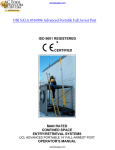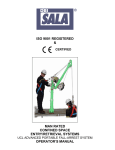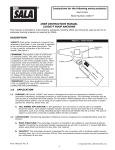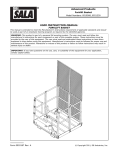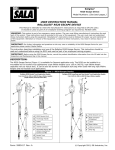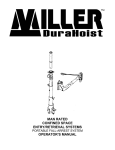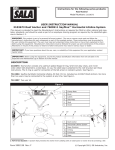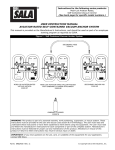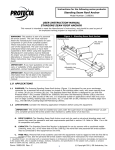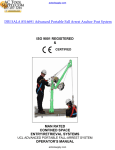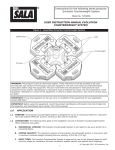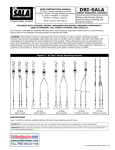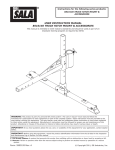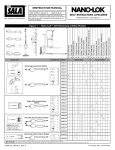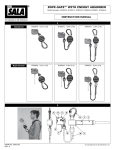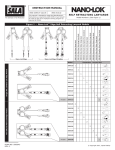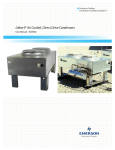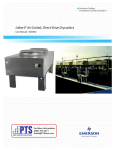Download Portable 14` Fall Arrest Post, Pt# 16996
Transcript
ISO 9001 REGISTERED MAN RATED CONFINED SPACE ENTRY/RETRIEVAL SYSTEMS UCL ADVANCED PORTABLE 14’ FALL-ARREST POST OPERATOR’S MANUAL SERIAL NUMBER LOCATION Always give your dealer or distributor the serial number of your UCL ADVANCED Portable 14 Foot Fall-Arrest Post when ordering parts or requesting service or other information. The serial number plate is located where indicated. Please mark the number in the space provided for easy reference. SERIAL NUMBER LABEL Model____________________________ Serial Number_____________________ TABLE OF CONTENTS SECTION DESCRIPTION PAGE 1 INTRODUCTION 1 2 SAFETY 2 2.1 2.2 2.3 General Safety Operating Safety Maintenance and Inspection Safety OPERATING, NEW OPERATOR OR OWNER 3 3.1 3.1.1 3.1.2 3.2 3.2.1 3.2.2 3.2.3 3.2.4 3.3 4 Portable 14’ Fall-Arrest Post Mounting Bases 11 Storage Maintenance 4.2 Inspection 4.3 Inspection Log 6 7 General Installing the Weld On Plate Installing the Portable Mounting Bases Set-up of the Portable Fall-Arrest Post 4.1 12 LABELS 5.1 5 General Setting Up the Portable Fall-Arrest Post MAINTENANCE AND INSPECTION 5 3 4 4 13 17 Warning Labels SPECIFICATION SHEETS i 18 Congratulations on your purchase of a UCL Advanced Safety Systems Portable Fall Arrest System. This equipment has been designed and manufactured to meet the needs of a discriminating operator in the variety of fall-arrest, confined space entry/retrieval and rescue situations. Safe, efficient and trouble free operation and maintenance of your equipment requires that you or anyone else who will be operating, maintaining or inspecting the equipment, read, understand and follow all the Safety, Operation, Maintenance and Inspection instructions contained in this manual, and in any related manuals referenced in this manual and/or supplied with the system. This manual covers the UCL ADVANCED PORTABLE FALL-ARREST SYSTEM and Accessories manufactured by Unique Concepts. Use the Table of Contents or Index as a guide when searching for specific information. WARNING This product is a part of a Man Rated Confined Space Entry/Retrieval System. The user must read, understand, and follow the instructions contained in the manual for each component or total system before using this equipment. Establish an appropriate training, maintenance, and inspection program for your people and the equipment. Failure to follow these instructions could result in serious injury or death. Keep this manual handy for frequent reference and to pass to new operators or visit our website for this manual at http://www.uclsafetysystems.com. Establish a regular training program for experienced and new operators per these instructions. Establish a regular maintenance and inspection program to keep the equipment in top condition. The UCL ADVANCED PORTABLE FALL-ARREST SYSTEM is a modular system of Portable Fall Arrest Anchor Posts, Extensions, and Support Bases designed to address a wide variety of Fall-Arrest and Confined Space Entry/Retrieval and Rescue applications. Modular components are labelled with the capacities and rating to which they were designed, tested, and manufactured. The rating of any system is considered to be the rating of the lowest rated component contained is the system. Do not use the equipment if rating labels are damaged or illegible. New labels are available from the manufacturer or your local authorized dealer. When ordering replacement labels, be sure to include: 1) The part number from the bottom right hand corner of the label, when available. 2) The serial number of the unit. 3) The part (item) number of the component (consult the appropriate section of this manual). 4) Any other numbers stamped on the components. 1 SAFETY ALERT SYMBOL This Safety Alert symbol means ATTENTION! BECOME ALERT! YOUR SAFETY IS INVOLVED! The Safety Alert symbol identifies important safety messages on your UCL Equipment and in the manual. When you see this symbol, be alert to the possibility of personal injury of death. Follow the instructions in the safety message. Why is SAFETY important to you? 3 Big Reasons SIGNAL WORDS: Note the use of the signal words DANGER, WARNING, and CAUTION with the safety messages. The appropriate signal word for each message has been selected using he following guide-lines: Accidents Disable and Kill Accidents Cost You Money Accidents Can Be Avoided DANGER - Indicates an imminently hazardous situation that, if not avoided, will result in death or serious injury. This signal word is to be limited to the most extreme situations, or for hidden or unseen hazards. WARNING - Indicates a potentially hazardous situation that if not avoided, could result in death or serious injury, and includes obvious and hidden hazards. It may also be used to alert against unsafe practices. CAUTION - Indicates a potentially hazardous situation that, if not avoided, may result in minor or moderate injury. It may also be used to alert against unsafe practices. 2 SAFETY YOU are responsible of the SAFE operation, maintenance and inspection of your UCL Advanced Portable Fall-Arrest System. YOU must ensure that you and anyone else, who is going to operate, maintain, inspect or work around the equipment be familiar with the operating and maintenance procedures and related SAFETY information contained in this manual. This manual will take you step-by-step through your working day and alerts you to all good safety and operating practices while using the equipment. Remember, YOU are the key to safety. Good safety practices not only protect you, but also the people around you. Make these practices a working part of your safety program. Be certain that EVERYONE operating this equipment is familiar with the procedures recommended and follows safety precautions. Remember, most accidents can be prevented. Do not risk injury or death by ignoring good safety practices. • • • • • Owners must give operating instructions to operators or employees before allowing them to use the equipment, and at least annually thereafter. The most important safety device on this equipment is a SAFE operator. It is the operator’s responsibility to read and understand ALL Safety and Operating instructions in the manual and to follow these. All accidents can be avoided. A person who has not read, been trained in using and understood all operating and safety instructions is not qualified to operate this equipment. An untrained operator exposes himself and others to possible serious injury or death. Do not modify the equipment in any way. Unauthorized modification may impair the function and/or safety and could affect the life of the equipment. Think SAFETY! Work SAFELY! 2.1 GENERAL SAFETY 1. Read, understand and follow the User Manual and all safety signs before using, maintaining or inspecting the equipment. 2. Refer to and follow applicable ANSI, OSHA, CE or other Standards and local regulations. Comply with requirements of local regulations for your applications. 3. Establish an equipment–use training program for experienced employees. Only trained, competent persons shall use the equipment. An untrained operator is not qualified to operate the system. 4. Have a first-aid kit available for use should the need arise and know how to use it. 5. Provide a fire extinguisher for use in case of an accident. Store in a highly visible place. 6. Install and properly secure all guards and shields before operating. 7. Wear appropriate protective gear. This list includes but is not limited to: - A hard hat Safety glasses Protective shoes with slip resistant soles Heavy gloves Protective clothing Face protection 8. Review and follow the Pre-Operation Inspection before using a component in the system or the system itself. 9. Establish a regular Maintenance and Inspection program with your equipment and maintain detailed records. 10. Review safety related items and operating instructions with all personal on a regular basis. 11. Be aware of your environmental surroundings, be sure not to use the equipment during an electrical storm. (this equipment is conductive) 12. When using our winch with our equipment, the noise level does not exceed 70 dB(A). 3 2.2 OPERATING SAFETY 1. Read, understand and follow the User Manual and signs on the equipment before using, maintaining or inspecting the equipment. 2. Train all operators before allowing them to use the equipment. An untrained operator exposes themselves, bystanders and co-workers to possible serious injury or death. 3. Visually inspect the equipment and all auxiliary components and equipment before using. Correct any problems before using the equipment. 4. Securely anchor all winches and /or SRL’s before using, where applicable. 5. Use only certified anchor and connector components in your system. 6. Use only an approved full body harness for the workers. 7. Always work in teams. One person works in the confined space and the other one pays out the line and reels it in. 8. Do not use the winch when the brake wear indicator displays excessive wear, the overload indicator on the snap has been activated, or the manufacturer’s service interval has been exceeded. Return winch to manufacturer for service. (Refer to the appropriate Winch Operators Manual for detailed information on winch operation.) 9. Do not exceed the winch’s rated working load during operation. 10. Establish a regular training program for new and experienced workers. 11. Establish a detailed inspection program for your equipment and document the findings. Return the equipment to the manufacturer for rework if any problems are found. 4 12. Plan your work program before starting. Have the required people, equipment and procedures available to do the job. 13. Do not use the equipment around physical or environmental hazards. This list includes but is not limited to: a. Corrosion that may affect the structural integrity of the life line or other components . b. Chemicals which can degrade components and not be visible. c. Toxic gases: Rescuers or workers can be killed in toxic environments. d. Heat or elevated temperatures. e. Moving machinery: Workers or auxiliary equipment can be contacted by or pulled into moving components. f. Sharp edges: Workers or the equipment can be injured or damaged by sharp edges or components. g. Electrical hazards: Stay away from power lines or components carrying electrical power. h. Overload: Do not exceed rated working load limit during operation. i. Follow confined space regulations in Standards. 2.3 MAINTAINANCE/INSPECTION SAFETY 1. Read, understand and follow the User Manual and signs on the equipment before using, maintaining or inspecting the equipment. 2. ANSI, OSHA & CE require a regular inspection program for all Confined Space Entry/Retrieval Equipment and to maintain documented results of these inspections. Follow the inspection procedure contained in this manual and use the inspection form to document the results. 3. Keep instructional and safety signs clean and legible at all times. Clean or replace as required. 4. Lubricate winch as per instructions in the appropriate Winch Operators Manual. 5. Remove the equipment from service if a problem is found during the inspection. Return to an authorized repair depot or the factory for service. 3 OPERATING, NEW OPERATOR OR OWNERS The UCL ADVANCED PORTABLE FALLARREST SYSTEM is designed to attach to a person working at a height to provide protection against injuries resulting from a fall. Various accessories address a variety of fall-arrest requirements, as well as confined space entry/retrieval and rescue needs. Every new operator must read, understand and follow the instructions in all applicable manuals. No one should be allowed to use the equipment without training. The training should be reviewed with experienced operators on a regular basis. At regular intervals perform a detailed inspection of the equipment and document the results. Remove from service if deficiencies are found. Alterations or misuse of this equipment or failure to follow instructions, may result in serious injury of death. It is the responsibility of the owner’s organization or operator to read this manual and to train all other operators before they start working with the equipment. Follow all safety instructions exactly. Safety is everyone’s business. By following recommended procedures, a safe working environment is provided for the operator, bystanders and the area around the work site. Untrained operators are not qualified to operate the equipment. Many features incorporated into this equipment are the result of suggestions made by customers like you. Read this manual carefully to learn how to operate the equipment safely and how to set it to perform as intended. By following the operating instructions in conjunction with a good maintenance program, your equipment will provide many years of trouble-free service. 5 OPERATING SAFETY 1. Read, understand and follow the User Manual and signs on the equipment before using, maintaining or inspecting the equipment. 2. Train all operators before allowing them to use the equipment. An untrained operator exposes themselves, bystanders and workers to possible serious injury or death. 3. Visually inspect the equipment and all auxiliary components and equipment before using. Correct any problems before using the equipment. 4. Securely anchor the winch before using. 5. Use only certified anchor and connector components in your system. 6. All anchor points, or mounting/setup locations for permanent or portable systems must be approved to local standards by a qualified engineer. 7. Use only an approved body harness for the workers. 8. Always work in teams. One person works in the confined space and the other one pays out the line and reels it in. 9. Do not use the winch when the brake wear indicator displays excessive wear, the overload indicator on the snap has been activated, or the manufacturer’s service interval has been exceeded. Return winch to manufacturer for service. (Refer to the appropriate Winch Operators Manual for detailed information on winch operation.) 10. Use only retractable lifelines or shock absorbers with a maximum arrest force (MAF) rating equal to or lower than ½ of the strength of the lowest rated component of your system. 6 11. Establish a regular training program for new and experienced workers. 12. Establish a detailed inspection program for your equipment and document the findings. Return the equipment to the manufacturer for rework if any problems are found. 13. Plan your work program before starting. Have the required people, equipment and procedures available to do the job. 14. Do not use the equipment around physical or environmental hazards. This list includes but is not limited to: a. Corrosion that may affect the structural integrity of the life line or other components. b. Chemicals which can degrade components and not be visible. c. Toxic gases: Rescuers or workers can be killed in toxic environments. d. Heat or elevated temperatures. e. Moving machinery: Workers or auxiliary equipment can be contacted by or pulled into moving components. f. Sharp edges: Workers or the rescue equipment can be injured by or damaged by sharp edges or components. g. Electrical hazards: Stay away from power lines or components carrying electrical power. h. Overload: Do not exceed rated working load limit during operation. i. Follow confined space regulations in Standards. j. Noise: wear appropriate noise protection where necessary. k. Environmental hazards: do not operate equipment during electrical storms. 3.1 14’ PORTABLE FALLARREST POST 3.1.1 General The UCL ADVANCED 14’ PORTABLE FALL-ARREST POST is a modular unit consisting of a 3 section tubular body, constructed of welded aluminum, featuring: 1. A head assembly equipped with a swivel tie-off ring. 2. Various mounting bases to address different situations. 3. Adjusting screws and level indicator for vertical leveling of the Fall-Arrest Post when installed on inclined surfaces. 4. Featuring adjustable height option from 82.0 (2083mm) to 168 (4267mm) inches. Figure 3.1.1 7 Regulations governing Fall Protection, Confined-Space Entry/ Retrieval and Rescue Procedures vary with jurisdiction. It is the responsibility of the owner and/or user of this equipment to be aware of applicable regulations and ensure that equipment selected for each job complies with these requirements. When using a UCL ADVANCED 14’ PORTABLE FALL-ARREST POST the rating of any particular system is defined as the rating of the lowest rated component in the system. Check the rating label on each system component before using to ensure that the rating meets all applicable regulatory requirements. Refer to the appropriate section of this or any other applicable manuals for specific information on the installation and use of the type of base you are using prior to using the system. Do not use any equipment on which any of the warning, rating or other labels have been removed, become damaged, or are otherwise illegible. Refer to Section 5 of this manual “Labels”, or to the appropriate section of the applicable system manual for information on ordering replacement labels. 3.1.2 10 7 Setting Up the Portable Fall Arrest Post 6 The UCL ADVANCED 14’ PORTABLE FALLARREST SYSTEM POST is designed for use with a variety of portable and permanent mount support bases. Consult the appropriate section of this manual or separate manuals when setting up or installing any UCL Portable Fall Arrest Bases. Step 1: Before setting up for any work at heights, fall arrest, or confined space entry be sure that you have all equipment required to safely carry out the work to be performed, and to meet all applicable standards and regulations for your area. Step 2: Set-up or locate the Portable Fall Arrest System Base intended for use in the application according to the instructions in the applicable section of this manual. Ensure that the base is structurally sound and free of any corrosion or contamination which may affect the insertion of the connecting pin or the structural integrity of the base. 1 9 2 3 4 5 6 7 7b 5 7b 8 9 10 11 12 13 12 8 4 Figure 3.1.1 11 8 Base Plate Tabs ¾” Pin Adjuster Screw Section 1 Section 2 Section 3 Swivel Tie off Ring/ Socket Section 2 Socket Section 1 Pin Section 2 Pin SRL Device I-Beam Base 14’ F/A Post Extension Pole Step 3: As shown in Fig. 3.1.2, insert the 14’ Portable Fall Arrest Post (12) between the base plates tabs (1) and visually align the ¾” holes as shown in Fig. 3.1.2. Secure the Post by inserting the ¾” pin (2) through the base plate tabs (1) and sleeve (12). Make sure the pin fully engages both the base plate tabs (1) and the entire post to lock the post firmly in place. Step 4: Before extending the post, tag the SRL lifeline snap hook onto the handle of the unit so it is accessible to clip the operator to the SRL prior to climbing. This post is capable of adjustment to a variety of heights below 14 feet by adjusting the sections of the post. Adjust the post according to the height of the application that the work is performed. Extend the post by removing both pin assemblies (8&9). Using the extension pole (13), insert the pole into the socket on Section 3 align the holes and secure using pin assembly (9), shown in Figure 3.1.4a & b. Extend section 2 by inserting the pole into the socket and push up to align the holes and secure using pin assembly (8). Step 5: The 14’ Portable Fall-Arrest Post (Fig. 3.1.1) must be in a vertical position at all times when it is being used as a FallArrest anchor point. Depending on the type of base you are using the Post may be leveled by using the adjuster screws (3) the base plate (11) or a combination of these, shown in Figure 3.1.3. The adjuster screws are alternately loosened and tightened to level the Post. 12 1 2 11 Figure 3.1.2 12 3 11 Figure 3.1.3 7 13 Figure 3.1.4a 11 Figure 3.1.4b 9 Step 6: Once the system is set-up inspect all components, fasteners, and other parts for wear, damage, corrosion, looseness, or any other condition that may reduce the integrity of the system. Components which are worn, damaged, corroded, or loose, must be tagged, marked with “DO NOT USE” or like wording and prevented from being used until repaired or replaced as required. Step 7: Following all instructions contained in the manufacturer’s instructions for any PFAS or any other devices being used, the appropriate section of this manual or other manuals for any UCL Accessories being used, and all applicable standards or regulations governing Fall Protection, Confined Space Entry/ Retrieval and Rescue for your area proceed with the work. 10 3.2 MOUNTING BASES 3.2.1 Weld-on Plates Weld-on Plates (Pt.# 10816, 16775, 16776, 16777) are designed to be permanently welded to existing structures in locations of frequent work, or where use of portable base is impractical. These mounting plates are compatible with all UCL ADVANCED PORTABLE FALL-ARREST SYSTEM Posts and Accessories. Weld-on Plates permanently address Portable Fall-Arrest Anchor Post mounting base requirements for steel structures. 3.2.2 Installing Weld-On Plates Specific installation instructions are beyond the scope of this product operator’s manual. Consult UCL Safety Systems Product Specification Sheet #10816, 16775, 16776, 16777 for detailed information on welding procedures, mounting requirements and application restrictions. 3.2.3 Installing Portable Mounting Bases Specific installation instructions are beyond the scope of this product operator’s manual. Consult UCL Safety Systems Product Specification Sheet # 16997 (I-Beam Clamp Base) or 16804 (Tripod Base) for detailed information on mounting procedures, mounting requirements and application restrictions. 3.2.3 Set-up of the 14’ Portable Fall-Arrest Post Install and level the Portable Fall-Arrest Post as outlined in Section 3.1.2. WARNING WARNING All anchor points or mounting/set-up locations for permanent or portable systems must be approved to local standards by a qualified engineer and must comply with all mounting requirements and application restrictions as outlined on the applicable UCL Product Specification Sheet. Failure to follow this restriction may result in serious injury or death. 11 3.3 STORAGE Prior to storage, the Portable Fall Arrest System should be thoroughly inspected and maintained. Return for repair or replacement of any worn or damaged components to prevent any unnecessary down time at the next use. Follow this procedure: 1. Thoroughly clean the Portable Fall Arrest system using mild soap on the body and labels. Be sure the labels are legible. Refer to Section 5 for information on ordering replacement labels if any are damaged or become illegible. 2. Use a neutralizing solution to clean lifeline. This is particularly important if the unit had been used in corrosive or toxic environments. 3. Perform a complete inspection of the unit and document the results. 4. Touch up all nicks and scratches to prevent corrosion. 5. Store in a cool dry place. Please contact your local dealer or the manufacturer if your winch requires this modification. 12 4 MAINTENANCE AND INSPECTION MAINTENANCE/INSPECTION SAFETY 1. Read, understand and follow the User Manual and signs on the equipment before using, maintaining or inspecting the equipment. 2. ANSI and OSHA requires a regular inspection program for all Confined Space Entry/Retrieval Equipment and to maintain documented results of these inspections. Follow the inspection procedure contained in this of any other applicable the manual and use the inspection form(s) to document the results. 4.1 Maintenance 4.1.1 Maintenance Intervals 3. Keep instructional and safety labels clean and legible at all times. Clean or replace as required. See Section 5 for label information and part numbers. 4. Remove the equipment from service if a problem is found during the inspection. Return to an authorized repair depot or the factory for service. Daily Annually or As Required 1. Visual Inspection Perform a complete visual inspection. Refer to Section 4.2.1. Remove from service if a defect is found. 1. Clean Portable Fall Arrest System Thoroughly clean the Portable Fall Arrest system using mild soap on the body and labels. Be sure the labels are legible. Refer to Section 5 for information on ordering replacement labels if any are damaged or become illegible. Weekly 1. Functional Inspection Perform a functional inspection. Refer to Section 4.2.2. Record results and keep documentation. 2. Complete Inspection Perform a complete inspection. Refer to Section 4.2 & 4.3. Record results and keep documentation. 13 4.2 Inspection 4.2.1 Visual Inspection A complete visual inspection should be performed on the Portable Fall-Arrest System equipment you are using prior to the operation. The following items should be checked; and the results recorded on the “Inspection Log” sheet (see Section 4.3). 1. Labels Check that all labels are clean and legible. Clean the labels if any are dirty using a mild soap and a damp cloth. Replace if any are illegible (Refer to Section 5 for a listing of all labels). 2. Fasteners Check that all screws and other fasteners are tight. If any are loose, tighten as required. Contact your local dealer or UCL manufacturer for any replacement fasteners that may be required 3. Structural Components Check the components for cracks, dents, bends, or breaks. Minor cosmetic damage in the component body will not affect the function of the Portable Fall-Arrest System. However if there are major dents or any other structural damage, the unit should be removed form service and returned to the manufacturer for service. 4. Corrosion Check all components for damage from corrosion. Although all components resist corrosion, working in corrosive environments can lead to damage. Inspect all structural components and fasteners for signs of damage. If corrosion damage is found, remove from service and return to the manufacturer for service. 14 4.2.2 Functional Inspection A functional check should be performed on the Portable Fall-Arrest System prior to every use. The following functional tests should be done; and the results recorded on the “Inspection Log” sheet (Section 4.3). 1. System Operation and Adjustments The Portable Fall Arrest System contains operational parts that may include pulleys and /or rollers. These parts must be carefully checked for chips, cracks, or worn areas that can cause malfunction during operation of the system. Make sure that all the adjustment points are in full functional condition. This may include parts that contain pins, bolts, tri-screws, and adjusting screws. There are also mechanical adjustments which may include, adjustable legs, sleeves, adjustable sliding blocks, and brackets. These areas must be kept clean from debris and corrosion for proper functional use. If any part of the system that includes all listed items above becomes damaged contact your local dealer or manufacturer for parts and/or service. 2. SRL and other Accessory Inspection Refer to the manufacturer’s operator’s manual or instructional material for proper functional inspection procedures for SRL’s and accessories not covered by this manual. 15 16 5 LABELS 5.1 Warning Labels The UCL ADVANCED 14’ PORTABLE FALLARREST POST uses a label rating system that is attached to all components on the system. The operator and/or entrant must establish the local standards by a qualified engineer and only then, a decision can be made by the rating labels as to which is the lowest rated component and if it meets or exceeds local standards. Proper maintenance of the labels must be established by the operator/entrant to keep system use safe. If labels are damaged the operator/entrant must enforce a lock-out/tag-out procedure. New labels are available from the local dealer or UCL manufacturer. 17 6 SPECIFICATION SHEETS 6.1 General These specification sheets contain information necessary for the proper installation and use of the equipment mentioned in this manual. These specifications contain application specific ratings and mounting requirements determined through design and testing. Please read and follow these specification sheets carefully to ensure the proper installation of each item. 18 14' (4.2 m) PORTABLE FALL ARREST SYSTEM POST MODEL: 16996 SAFETY SYSTEMS SPECIFICATIONS PAGE 1 of 2 Model 16996 includes the following Item Part no. 1 16996 2 n/a Description 14' POST ASSEMBLY LIFTING POLE 2250 lb. (10 kN) DESCRIPTION The UCL Safety Systems 14' Portable Fall Arrest Post is designed for use with various mounting systems to provide an overhead fall-protection anchor point to workers. The telescoping is raised from ground level using the lifting pole. Various weld-on plates are available as is a portable I-Beam Base designed to clamp an existing I-beam. The light-weight aluminum structure is powder coated and anodized for corrosion resistance. General Specifications: Working Load Proof Load Proof Tests Weight Application Restrictions 310 lbs. (141 Kgs.) 2250 lbs @ 20° UCT - 392, 393 59 lbs. (26.8 kgs) Materials & Construction: General Construction Weld Certification Material (aluminum) Finish (aluminum) Material (steel) Finish (steel) Hardware Plating Specification Welded Steel / Aluminum CWB-47.1, CWB-47.2 6061-T6 Aluminum Yellow powder coat/Clear Anodize H.R. Steel Plate, Sch. 40 Pipe Zinc Plated Gr.5, Gr.8 - Zinc Plated ASTM Designation B633-85, Type II, III, SC2 Mounting Requirements(minimum): 1. This device is intended for use with equipment and accessories manufactured and/or approved by Unique Concepts Ltd. 2. Load MUST BE applied at an angle not to exceed 20° as shown. 3. MUST BE used with a shock absorber or retractable device with an M.A.F. rating of 900 lb. (4 kN) or less. 4. Where required by regulation, each installation MUST BE approved to all applicable local standards by a qualified engineer. 5. All equipment MUST BE set up and operated under the supervision of a competent person according to the manufacturer's instructions. Weld-on Plates, I-Beam Mount or Other used to support the Model 16996 14' Post MUST BE mounted to a suitable structure, using appropriate fasteners, capable of withstanding the following loads: 1) A 130,000 in-lb (14690 N.m) moment. 2) A 2250 lb. (1023 Kg) vertical load. Installation MUST BE approved to local regulations by a qualified engineer. Manufactured by: Unique Concepts Ltd., 1500 King Edward St., Wpg., MB., Canada, R3H-0R5 Phone: (204) 694-7432 Fax: (204) 694-7612 Toll Free: 1-800-455-9673 E-mail: [email protected] ISO 9001 REGISTERED Printed in Canada UCLS16996.02.10.07REV00 Copyright 2002 SAFETY SYSTEMS SPECIFICATIONS PAGE 2 of 2 14' (4.2 m) FALL-ARREST POST, PORTABLE FALL ARREST SYSTEM MODEL: 16996 Available System Heights Position Height 1 82 2 98 3 116 4 118 5 132 6 134 7 152 8 168 H Manufactured by: Unique Concepts Ltd., 1500 King Edward St., Wpg., MB., Canada, R3H-0R5 Phone: (204) 694-7432 Fax: (204) 694-7612 Toll Free: 1-800-455-9673 E-mail: [email protected] ISO 9001 REGISTERED Printed in Canada UCLS16996.02.10.07REV00 Copyright 2002 LIMITED LIFETIME WARRANTY Warranty to End User: D B Industries, Inc., dba CAPITAL SAFETY USA (“CAPITAL SAFETY”) warrants to the original end user (“End User”) that its products are free from defects in materials and workmanship under normal use and service. This warranty extends for the lifetime of the product from the date the product is purchased by the End User, in new and unused condition, from a CAPITAL SAFETY authorized distributor. CAPITAL SAFETY’S entire liability to End User and End User’s exclusive remedy under this warranty is limited to the repair or replacement in kind of any defective product within its lifetime (as CAPITAL SAFETY in its sole discretion determines and deems appropriate). No oral or written information or advice given by CAPITAL SAFETY, its distributors, directors, officers, agents or employees shall create any different or additional warranties or in any way increase the scope of this warranty. CAPITAL SAFETY will not accept liability for defects that are the result of product abuse, misuse, alteration or modification, or for defects that are due to a failure to install, maintain, or use the product in accordance with the manufacturer’s instructions. CAPITAL SAFETY’S WARRANTY APPLIES ONLY TO THE END USER. THIS WARRANTY IS THE ONLY WARRANTY APPLICABLE TO OUR PRODUCTS AND IS IN LIEU OF ALL OTHER WARRANTIES AND LIABILITIES, EXPRESSED OR IMPLIED. CAPITAL SAFETY EXPRESSLY EXCLUDES AND DISCLAIMS ANY IMPLIED WARRANTIES OF MERCHANTABILITY OR FITNESS FOR A PARTICULAR PURPOSE, AND SHALL NOT BE LIABLE FOR INCIDENTAL, PUNITIVE OR CONSEQUENTIAL DAMAGES OF ANY NATURE, INCLUDING WITHOUT LIMITATION, LOST PROFITS, REVENUES, OR PRODUCTIVITY, OR FOR BODILY INJURY OR DEATH OR LOSS OR DAMAGE TO PROPERTY, UNDER ANY THEORY OF LIABILITY, INCLUDING WITHOUT LIMITATION, CONTRACT, WARRANTY, STRICT LIABILITY, TORT (INCLUDING NEGLIGENCE) OR OTHER LEGAL OR EQUITABLE THEORY. A Capital Safety Company CSG USA & Latin America 3833 SALA Way Red Wing, MN 55066-5005 Toll Free: 800.328.6146 Phone: 651.388.8282 Fax: 651.388.5065 [email protected] CSG Canada 260 Export Boulevard Mississauga, ON L5S 1Y9 Phone: 905.795.9333 Toll-Free: 800.387.7484 Fax: 888.387.7484 [email protected] CSG Northern Europe Unit 7 Christleton Court Manor Park Runcorn Cheshire, WA7 1ST Phone: + 44 (0)1928 571324 Fax: + 44 (0)1928 571325 [email protected] CSG EMEA (Europe, Middle East, Africa) Le Broc Center Z.I. 1ère Avenue 5600 M B.P. 15 06511 Carros Le Broc Cedex France Phone: + 33 4 97 10 00 10 Fax: + 33 4 93 08 79 70 [email protected] CSG Australia & New Zealand 95 Derby Street Silverwater Sydney NSW 2128 AUSTRALIA Phone: +(61) 2 8753 7600 Toll-Free : 1 800 245 002 (AUS) Toll-Free : 0800 212 505 (NZ) Fax: +(61) 2 87853 7603 [email protected] CSG Asia Singapore: 16S, Enterprise Road Singapore 627666 Phone: +65 - 65587758 Fax: +65 - 65587058 [email protected] www.capitalsafety.com I S O 9001 Certificate No. FM 39709 Shanghai: Rm 1406, China Venturetech Plaza 819 Nan Jing Xi Rd, Shanghai 200041, P R China Phone: +86 21 62539050 Fax: +86 21 62539060

























